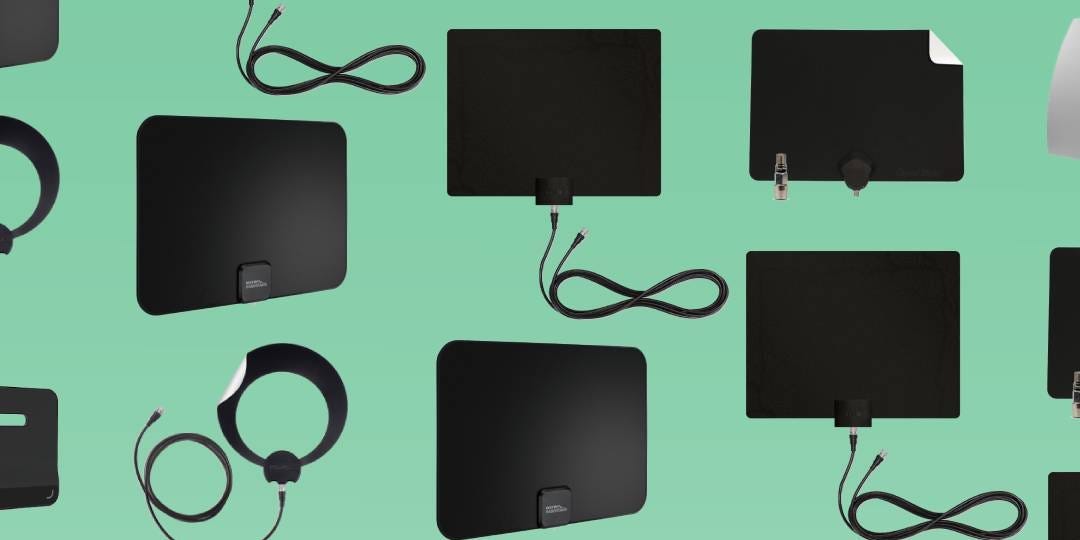An indoor TV antenna is a cheap and simple way to get local broadcast channels without paying for cable or a live TV streaming service. And nowadays, the best indoor TV antennas are paper-thin, sleek, and easily hidden, so you don’t have to worry about clunky telescoping rods sullying your sleek entertainment setup.
Instead of paying a hefty monthly bill, you can score a solid antenna for a one-time payment as low as $20. If your area has proper reception, this affordable investment will give you free access to local stations like ABC, NBC, CBS, and Fox. Some of our top picks include the Channel Master FLATenna for its reliable performance and the Mohu Leaf Fifty for its easy setup.
Below, you can find all of our recommendations for the best indoor TV antennas you can buy. Our picks are based on hands-on testing and expert research on popular brands.
Best overall
Channel Master FLATenna 35 Duo
Channel Master’s FLATenna 35 Duo is one of the most affordable antennas on the market, and it delivers great reception for local channels.
This paper-thin Channel Master antenna is easy to set up and is rated for a reception range of 35 miles. You just need the 3M tape included in the package to install it on a wall or window. Though the product’s original listing on Amazon didn’t include a coaxial cable, the antenna now comes with one.
During our tests, we received all of the major local networks in our area, including ABC, NBC, CBS, and Fox. It also picked up a lot of Spanish-language channels, including Univision, Azteca, Estrela, and more. Other local stations, like Crime and GetTV, came through without any issues. In total, the antenna could pick up about 79 stations, which is excellent.
Though a handful of those channels did come through a bit choppy (these were likely being broadcast a bit too far from our area), we were able to pick up all the major networks with reliable reception. Channel Master also bundles this antenna with an amplifier for an additional $20. The amp could help boost signal reception in certain cases, but we don’t think it’s worth the extra money for most people.
Other indoor TV antennas we recommend
When you buy through our links, Business Insider may earn an affiliate commission. Learn more
-
This lightweight antenna is the same model as our best overall pick, but it comes bundled with an amplifier
-
If you’re looking for something to blend in with your home, this is one of the only transparent antennas you can buy.
-
This antenna offers a solid range at a super-low price. Just plug it into your TV’s tuner to start watching.
-
Rather than wall-mounting it, this sleek antenna is designed to rest on any surface near your TV.
-
This antenna is good for tight spaces thanks to its thin and slightly smaller size compared to most other options.
-
This amplified antenna is ultra-thin and easy to set up with included push pins to hold it in place.
-
Complete with an FM and LTE filter to eliminate interference, this premium antenna can be mounted or left free-standing.
-
This stable antenna can be set up indoors or outdoors but takes up more space than other options.
Antenna FAQs
How do I connect an indoor antenna to a TV?
To connect an indoor antenna to a TV, you must first ensure your display includes an integrated digital tuner. This is standard on all the best TVs, but you might need to purchase a separate digital tuner if you own a very old set.
Once you’ve found your TV’s turner port, all you need is a coaxial cable to run from the TV to your antenna. Some antennas come with this cord, but you’ll need to buy a separate one if it’s not included. If you want to place your antenna in the window or a space away from your TV, you should measure the distance beforehand to see if the cord is long enough.
Finally, if your antenna uses an amplifier, you must plug it into a power outlet.
What channels can I get with an antenna?
Antennas pick up over-the-air broadcast channels that are available in your area. This typically means local networks like NBC, ABC, CBS, Fox, and a few dozen other stations. Channel availability, however, can drastically differ depending on whether your community is more rural or urban.
One way to check available channels in your community is through the AntennaWeb tool. Just enter your address in the search bar, and a list of channels that can be picked up in your area will appear in the results.
Do you need a TV antenna with an amplifier?
Not all TV antennas include amplifiers, and in most cases, you’ll be fine without one. However, the farther away you live from a TV station tower, the more you may benefit from having one. Amplified TV antennas are designed to help increase signal strength, so they’re a better choice if you live in a rural area where reception isn’t as good.
On the other hand, amplified antennas often require a power source, meaning more pesky cables around your TV, and they can also amplify noise, which can sometimes make reception worse than it would be without an amp. If you live in an area closer to broadcast towers, a non-amplified option may serve you just as well and reduce the number of wires you need to manage.
What are the limitations of using an antenna?
Unlike cable or the best live TV streaming services, antennas can only pick up local channels. If you want to see content from cable networks like ESPN, AMC, FX, Disney Channel, and more, an antenna won’t work.
Antenna reception can also be limited by external factors in your area. This means the number of trees outside your home or nearby buildings could impact your viewing. The location of broadcast towers in your area, the weather, and your room’s shape and design can also impact your reception. In other words, the performance you get from an antenna can be more finicky compared to cable and streaming.
And unlike pay-TV options, an antenna on its own won’t let you record shows, though some external DVRs can be bought separately to save antenna broadcasts. Some TVs also lack the ability to display a full on-screen guide for antenna stations. This means you have to go through each channel manually. But, some newer smart TVs now include integrated guides for antenna playback.
What video quality can I get with an antenna?
Most over-the-air broadcasts currently offer high-definition (HD) picture quality with either 720p or 1080i resolution. This matches the resolution that most cable and live TV streaming services provide.
With that said, antenna-based broadcasts can look better than cable, even with the same resolution. Cable tends to compress video and audio quality more than antennas, so over-the-air TV through an antenna will typically provide improved quality. That is, as long as your reception is strong.
Over the next few years, some over-the-air stations will begin broadcasting in 4K (Ultra HD) and high dynamic range (HDR) through the new ATSC 3.0 standard, also called NextGenTV. NextGenTV broadcasts are already available in several major cities like Pittsburgh and Phoenix and continue to enter additional markets.
Current digital TV antennas can pick up NextGenTV signals without issues, so you don’t need to buy a specific 4K antenna. However, you will need an ATSC 3.0 tuner or a 4K TV with an integrated ATSC 3.0 tuner. Only select TVs released over the last few years have these built-in. You can find more information about ATSC 3.0 broadcast availability on the NextGenTV website.




